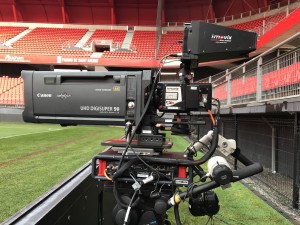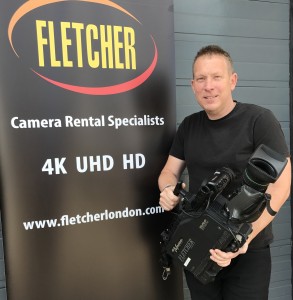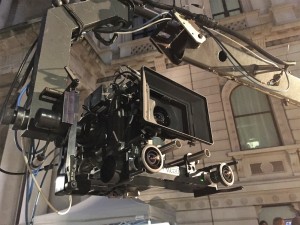SVG Europe Sit-Down: Fletcher London’s Haydn Parnell provides a rental company perspective on technology developments and training
Fletcher was created some 30 years ago in the United States as a camera systems provider specialising in live TV solutions that are suitable for both OB and studio environments. It now describes itself as specialists in Ultra Slow Motion rental for Broadcast TV with a selection of solutions from Sony and I-Movix for both 4K (UHD) and HD.
More traditional HD camera solutions are available from NAC with the Hi-Motion II, I-Movix USM, GVG C86 plus the ultra-compact PICO. Zoom extraction – real-time 4K to HD pan and scan – is provided from Evertz with the Dreamcatcher and Sony with the HDC-4800 and 4500 server combination. Completing the portfolio line-up is an innovative Augmented Reality (AR) real time camera tracking solution from Ncam.
The company opened up an office in London ready for 2012 – and from this facility it serves the rest of the world. In this interview, Haydn Parnell, the manager from the London office, starts off by discussing the impact on new technology on companies such as Fletcher.
What do you see as your biggest challenges for 2017?
I see 4K / UHD as our principal challenge for the coming year, and then juggling that technology with the advent of High Dynamic Range. Certainly, some of the equipment providers and vendors are doing enough to meet the anticipated demand – especially Sony who is striving forward with these developments. One problem is the cost of the equipment to meet the current requirements. Customers are used to having the now less expensive traditional HD interlaced 50i cameras, but to step forward with the pricing structure of the new cameras and technologies is a big challenge. As far as rental companies are concerned, for any business plan to be effective, we have to see the business ahead of us in order to justify the outlay. The parent company in Chicago are in a better position – they can go to the networks and obtain three year deals, whereas here in Europe, it is on an event-by-event basis.
Do you see the expansion of remote live production having an impact on your business?
This is definitely something for us to keep an eye on and watch very carefully. For the short term I don’t see this having an immediate effect on our business, indeed with standards still to be confirmed and agreed on it might be a while until IP based products fit well into a rental portfolio. However, having said that we are at the sharp end of what our customers want so we have to be adaptive to their needs. We are and will always keep looking for the next concept and breakthrough that could lead us into new technologies to expand our portfolio. This is both exciting and daunting especially considering the possible outlay if you decide to back the wrong horse as an early adopter. Time will tell on this one but the possibilities are certainly exciting.
With the continuing integration of IT and broadcast technologies, are the colleges producing engineers with the right knowledge base that are going to understand the rental market?
That is a very good question. Training is very high on the industry agenda these days. The truth is you have to know the basics before you can run. The problem is that most colleges offer a finite course of maybe one, two or three years – so they have to decide whether to teach the basics or get straight into the more involved content. I have been encouraged by recent initiatives by the likes of the NFTS and IMG to take a more pragmatic approach to this industry dilemma. I think it is true that colleges have become isolated from the broadcast market and therefore do not know what is really going on and that is a real concern. An idea from NEP Visions to have a student day is also a brilliant way of getting those learning the industry involved in the real world of broadcast. Actually, that will also help to bring on the lecturers to understand the needs. Training establishments can’t usually afford the infrastructure that is needed to meet all these requirements. I think internships and apprenticeships is the way forward, rather than just academia.
Where do you think we will be with HDR by the end of this year? Or should we be looking further ahead for significant take-up?
I think we need to be looking further ahead than this year. I believe this year is a test bed, and therefore expect 2018 will be quite a telling year for HDR. In the USA, for example, they seem to be looking at things a little different and have gone straight with tests from HD to HDR with less emphasis on UHD. You may say looking at the depth and quality of the pixel rather than the number of pixels on offer is key. When push comes to shove, the pictures in HDR are more stunning and vibrant in HD or UHD – that’s what viewers seem to want and we haven’t even discussed 8K HDR and beyond.
And how about 4K? Will there be any significant developments by the end of this year that will impact the rental sector?
Specialist cameras with 4K UHD capability are far better in that true native resolution. This does become a challenge when wanting to run in 8x, 12x or even up to 16x UltraSlowMotion. Most current replay backbone infrastructure needs multiple channels to record that level of high speed requirements that are both needed and expected by production. This means you could be taking up a complete replay server for just one camera. So, a compromise is starting to appear where the camera can be cut live on the desk in the native UHD resolution, but the replay channels are at 1080 50P and up-scaled. We are seeing developments from the camera manufacturers themselves that help this scenario. Take, for example, the Sony 4800 – it effectively is a camera and replay chain in one to give full live and replay UHD capability at true native resolutions. The traditional replay vendors will surely catch up with this extra headroom of performance needed but for the time being the HD 50P compromise will be around for a while.



